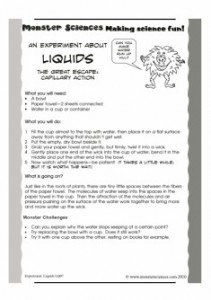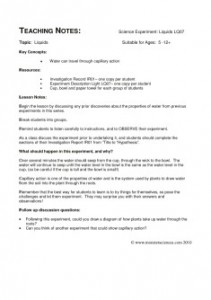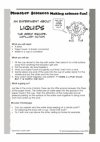Can you move water from one container to the other without touching them?
 |
 |
A science experiment about liquids – the great escape – capillary action
What you will need:
- A bowl
- Paper towel—2 sheets connected
- Water in a cup or container
What you will do:
- Fill the cup almost to the top with water, then place it on a flat surface away from anything that shouldn’t get wet.
- Put the empty, dry bowl beside it.
- Grab your paper towel and gently, but firmly, twist it into a wick.
- Gently place one end of the wick into the cup of water, bend it in the middle and put the other end into the bowl.
- Now watch what happens—be patient! it takes a little while, but it is worth the wait!
What is going on?
Just like in the roots of plants, there are tiny little spaces between the fibers of the paper towel. The molecules of water seep into the spaces in the paper towel in the cup. Then the attraction of the molecules and air pressure pushing on the surface of the water work together to bring more and more water up the wick.
Monster Challenges:
- Can you explain why the water stops seeping at a certain point?
- Try replacing the bowl with a cup. Does it still work?
- Try it with one cup above the other, resting on books for example.
Teaching Notes: Monster Sciences Experiment: Liquids LQ07
Topic:
Liquids
Key Concepts:
Water can travel through capillary action
Resources:
- Investigation Record IR01– one copy per student
- Experiment Description Light LQ07– one copy per student
- Cup, bowl and paper towel for each group of students
Lesson Notes:
Begin the lesson by discussing any prior discoveries about the properties of water from previous experiments in this series.
Break students into groups.
Remind students to listen carefully to instructions, and to OBSERVE their experiment.
As a class discuss the experiment prior to undertaking it, and students should complete the sections of their Investigation Report IR01 from ”Title to “Hypothesis”.
What should happen in this experiment, and why?
Over several minutes the water should seep from the cup, through the wick to the bowl. The water will continue to seep until the water level in the bowl is the same as the water level in the cup, (so be careful if the cup is tall and the bowl is small!)
Capillary action is one of the properties of water and is the system used by plants to draw water from the soil into the plant through the roots.
Remember that the best way for students to learn is to try things for themselves, so pose the challenges and let them experiment. They may surprise you with their answers and observations!
Follow up discussion questions:
- Following this experiment, could you draw a diagram of how plants take up water through the roots?
- Can you think of another experiment that could show capillary action?



